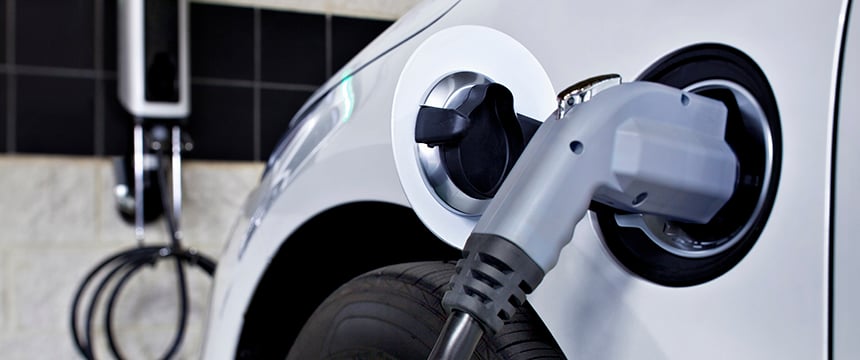Tax Credits in the Inflation Reduction Act Aim to Build a More Equitable EV Market

In February of this year, it was high time for me to buy a new car. I had driven the same car since 2008, and getting this-or-that replaced was costing more and more every year. As a first-time car buyer, I had two criteria: I wanted to go fast, and I wanted the car to plug in.
Like many prospective purchasers, I started my search online and by speaking with friends and who drove electric vehicles, or EVs for short. I settled on a plug-in hybrid sedan, reasoning that a plug-in hybrid electric vehicle (PHEV) was the best of both worlds: the 20-mile electric range was perfect for my short commute and getting around Houston’s inner loop, and the 10-gallon gas tank offered freedom to roam. In the eight months since I’ve had the car, I’ve bought less than ten tanks of gas. As the price of a gallon in Texas soared to $4.69 in June, the timing of my purchase seemed miraculous.
When it was time to transact, the dealer made vague mention of rebates and tax credits, but didn’t have a comprehensive understanding of the details. Enter Texas’s Light-Duty Motor Vehicle Purchase or Lease Incentive Program (LDPLIP). Administered by the Texas Commission on Environmental Quality (TCEQ), the program grants rebates of up to $5,000 for consumers, businesses, and government entities who buy or lease new vehicles powered by compressed natural gas or liquefied petroleum gas (propane), and up to $2,500 for those who buy or lease new EVs or vehicles powered by hydrogen fuel cells.
Rebates are only available to purchasers who buy or lease from dealerships (so some of the most popular EVs in the U.S. don’t qualify). There is no vehicle price cap, nor is there an income limit for purchasers. In June of 2022, the average price for a new electric vehicle was over $66,000, according to Kelley Blue Book estimates. But the median Texan household income (in 2020 dollars) for 2016-2020 was $63,826.
According to the grant specialist to whom I initially sent my application, the TCEQ has received “a vigorous response” from applicants, however, the TCEQ is limited in the number of rebate grants that it can award: 2,000 grants for EVs or vehicles powered by hydrogen fuel cells, and 1,000 grants for vehicles powered by compressed natural gas or liquefied petroleum gas (propane).
The grant period in Texas ends on January 7, 2023, but on July 5, 2022, the TCEQ suspended acceptance of applications for EVs or vehicles powered by hydrogen fuel cells. As of the writing of this post, the total number of applications received and reservations pending on the program’s website is 2,480.
In comparison with Texas’s rebate program, the EV tax credits in the Inflation Reduction Act of 2022 demonstrate a commitment to building a more equitable EV market. While EVs may be cheaper to own than gas-powered vehicles—especially when gas prices are high—a lot of lower and middle-income families have historically been priced out of the EV market. The IRA takes several meaningful steps towards accessibility and sustainability for a more diverse swath of consumers:
- Allows point-of-sale incentives starting in 2024. Purchasers will be able to apply the credit (up to $7,500) at the dealership, and because sticker price is such an important factor for so many purchasers, this incentive will make buying an EV more attractive up front.
- Removes 200,000 vehicle-per-manufacturer cap. Some American manufacturers are already past the maximum. Eliminating the cap means bringing back the tax credit for many popular and affordable EVs, which should attract new buyers.
- Creates income and purchase price limits. SUVs, vans, and pickup trucks under $80,000, and all other vehicles (e.g. sedans) under $55,000, will qualify for the EV tax credit. For new vehicles, purchaser income will be subject to an AGI cap: $150,000 for individuals and $300,000 for a joint filers.
- Extends the tax credit to pre-owned EVs. As long as the purchase price does not exceed $25,000, purchasers of pre-owned EVs (EVs whose model year is at least two years earlier than the calendar year in which the purchase occurs) will receive a tax credit for 30% of the sale price up to $4,000. The income cap for pre-owned EVs is $75,000 for individuals and $150,000 for a joint filers.
A purchaser who qualifies under both programs can get both incentives. Comparing Texas’s state government-level incentives and those soon to be offered at the federal level reveals a few telling differences—new vs. used, income caps, purchase price caps, post-purchase rebates vs. up-front point-of-sale incentives—but the differences all fall under the same umbrella: equity. The IRA’s tax credits are designed, among other things, to make purchasing an EV more attractive to a wider audience.
Of course, the EV incentive landscape has greatly changed since the Energy Improvement and Extension Act of 2008 first granted tax credits for new, qualified EVs. The LDPLIP wasn’t approved by the TCEQ until late 2013, so the U.S. government has arguably had more time to get it right. Some might say that the fact that Texas’s program offers the purchaser of the $150,000+ PHEV the same opportunity to access grant funds as the purchaser of the $30,000 EV means that the LDPLIP is even more “equal.”
It is worth noting that the IRA also sets a handful of production and assembly requirements. For instance, to qualify for the credit, a vehicle’s final assembly must occur in North America. Further, at least 40% the value of the critical minerals contained in the vehicle’s battery must be “extracted or processed in any country with which the United States has a free trade agreement in effect” or be “recycled in North America”—and this percentage increases each year, topping out at 80% in 2027. There is also a rising requirement that 50% of the vehicle’s battery components be manufactured or assembled in North America, with the requirement set to hit 100% in 2029. It is unclear whether automotive manufacturers and the U.S. critical mineral supply chains will be able to meet these targets—and that uncertainty may cause a potential limiting effect on the options a purchaser would have for EVs that qualify for the tax credit.
Time will tell whether the intentions behind the EV tax credits in the IRA have the effect that this particular blogger and PHEV owner is hoping for. While we wait to see whether this bid at creating an equitable EV market bears fruit, we can at least admire this attempt at, as the saying goes, “giving everyone a pair of shoes that fits.”
